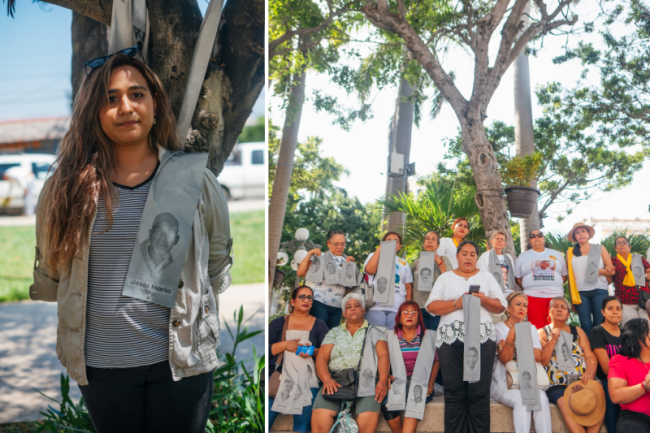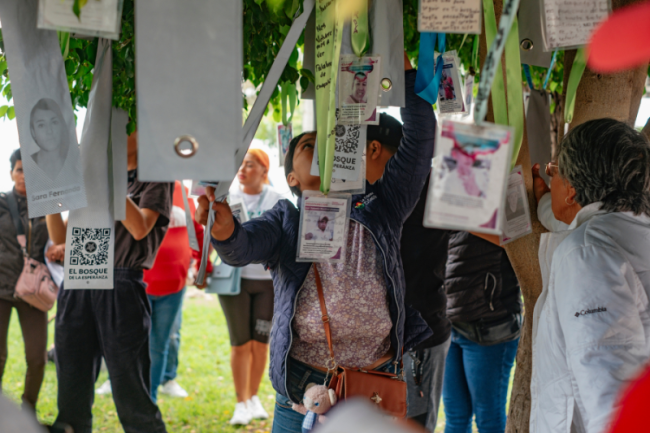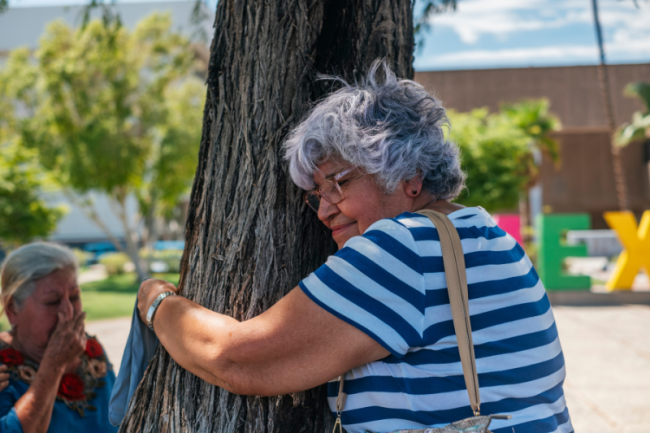
This piece appeared in the Summer 2024 issue of NACLA's quarterly print magazine, the NACLA Report. Subscribe in print today!
“We have to keep fighting for our loved ones, and now we have to fight against the disappearance of our treasures,” said Mili, who searches for her father, Jesús, disappeared in 2018 in Sinaloa, Mexico. Mili is a member of one of the 94 families who participate in El Bosque de la Esperanza, a memory effort that challenges the Mexican state’s control over narratives of the country’s ongoing crisis of disappearance. For several years, institutional reports, state-sponsored science, and improvised censuses have concealed the now 114,403* officially recognized records (registries) in the National Registry of Disappeared and Missing Persons (RNPDNO) as of the time of writing. Searching families speak of “the disappearance of the disappeared” to describe such state actions that remove the disappeared from official registries, and therefore from public discourse and institutional obligations.
Since disappearances surged in Mexico in 2006 with the declaration of the so-called war on drugs, these staggering numbers have often paralyzed widespread civilian efforts to resist and disarm violence. Aware of this challenge, families and advocates in Mexico insist that their tesoros or treasures—as they endearingly and collectively call their disappeared loved ones—“are persons, not registries.” Searching families kindle the flickering flame of memory by continuously naming, searching for, and sometimes even finding their treasures. It is El Bosque de la Esperanza’s goal to accompany them in preserving and keeping these memories alive.
Following Orlando Fals Borda, El Bosque de la Esperanza (Forest of Hope) is a participatory action-research project that takes shape as a dispersed, self-managed, affordable, and modular gathering of physical and virtual spaces of memory commemorating people affected by disappearance. Through in-person workshops held in 2023 in six cities across three Mexican states, 94 families participated in commemorating the disappearance of 101 persons. Together, we performed collective research to understand how El Bosque may develop aesthetic, theoretical, and political technologies of memory that can assist search collectives in their efforts to produce truth claims that bolster effective search actions. The overall aim is to strengthen the memory of the disappeared so it becomes a legitimate representation in public, if only to flicker ever more intensely until it is accepted and acted upon as collective and public truth. Much is at stake: searching for the disappeared is a race against time as the passage of days erodes the material and documentary traces in the forensic landscapes, to borrow Anne Huff schmid’s term, where evidence of the disappeared may be found. As these material remains fade, so does the possibility of resistance against political forces that impose their own truth claims over the memory of the disappeared.

Registries: Disappearing the Disappeared
In August 2021, a coalition of searching families and collectives published a report on Mexico’s “forensic crisis” using data collected from freedom of information requests. They found that there are more than 52,000 unidentified bodies in the country’s morgues and unmarked graves. Searching families pay special attention to these numbers because it is likely that a large number of disappeared persons remain lost for years among these unidentified bodies. After the study’s release, Mexico’s undersecretary for human rights, Alejandro Encinas, acknowledged the report and admitted to the existence of a forensic crisis.
In stark contrast to Encina’s response, about two years later, President Andrés Manuel López Obrador publicly questioned the trustworthiness of statistics on the disappeared, which at the time numbered over 113,000. He announced plans for a new census. The four-month study, carried out exclusively by federal government officials, concluded there are only 12,377 confirmed records of disappeared persons—less than 11 percent of the RNPDNO total and a mere quarter of the number of unidentified bodies. Search collectives immediately rejected the survey, and some publicly speculated the study was designed not to obtain an accurate count but “to disappear the disappeared” and obscure the fact that close to 40 percent of the total disappearances reported in Mexico since 1961 have taken place during the current administration. Families fear that if sheer political power can disappear from public view 89 percent of the records of their disappeared loved ones—a total figure calculated using empirically observable unidentified body counts and the paper trails of police reports—then the legal obligations of the Mexican state to search for and identify missing persons can be just as easily paralyzed.
Counting, as a methodology to establish a truth claim on the total of the disappeared, demands transparent, replicable, and verifiable methods grounded in empirical observation, scientific reasoning and knowledge, as well the correct use of technology. Though this is the intention behind the 114,403 active cases in the RNPDNO at the time of writing, evidence of disappearance originates in the memories of searching kin. When families report a disappearance, the investigating authorities are required by law to submit a record to the RNPDNO official database. However, those same authorities have been accused of and prosecuted for tampering with and obstructing—whether out of incompetence or for political-electoral reasons—this legally mandated counting process.

Furthermore, many disappearances in Mexico are described by witnesses, families, or prosecutors as enforced disappearances, a legal category signaling that local, state, and/or federal authorities actively or complicitly participated in the crime. An enforced disappearance implies that criminal state agents have control over evidence and investigations and, therefore, also maintain a grip on any possibility of being held accountable for their actions. As time advances, opportunities arise for institutions and their agents to neglect and damage documents and evidence, further complicating the possibility of elucidating this kind of violence against the memory of the disappeared. Amid such impunity, and out of fear of retaliation, many families choose to never report their kin as disappeared.
Given these hurdles, there is one point that both the official narrative and the search collectives can agree on: the RNPDNO has significant flaws in its state-sponsored scientific methodology, due to the webs of impunity that corrupt its data. This blind spot in the RNPDNO—known as la cifranegra or dark data—is instead counted privately only by those who directly suffer disappearance. In their mourning, the simultaneity of love and pain experienced by these communities of victims is fragile and does not always produce public reactions. There are many forces obscuring ongoing displays of memory, and as the disappearance crisis deepens, this memory flickers less and less in social space. One of those forces is political: AMLO has stated on several occasions that both the “irresponsible” RNPDNO count and acts of protest by search collectives are politically motivated. In August 2023, for example, the president refused to meet with mothers searching for their disappeared children, calling the purpose of such a meeting “manipulative.” “The important thing is that we help in the search for the disappeared … and we are doing it,” he claimed. “The rest is politicking.” Such statements not only discredit searching families’ painful experiences but also render invisible the very real violences that Mexicans suffer on the daily.
It’s not just rhetoric. In early 2024, AMLO’s administration dismantled key institutions charged with searching for and identifying the disappeared: 104 forensic experts were laid off from the National Search Commission, and the Extraordinary Mechanism for Forensic Identification (MEIF) was terminated. The MEIF was a body of national and international forensics experts created in 2019 after the Mexican government admitted to the disappearance crisis in hearings with the Inter-American Commission on Human Rights (IACHR). The legal document that enabled the MEIF’s creation states that “its duration will be determined by the fulfillment of its mandate” and that searching families will have substantive and permanent participation in all the body’s activities. There is no evidence families or independent experts took part in the government’s unilateral decision to terminate the MEIF. And yet, over 50,000 bodies remain unidentified in morgues and mass graves.

Members of search collectives often share that they feel abandoned, whether by family, friends, or society at large. Governments—and not just AMLO’s—often state that people become victims of crimes because they were involved in drug consumption, trafficking, or other criminal activities. Uttered from positions of power, these perceptions trickle down to the general public, where they inhibit empathy by criminalizing and stigmatizing people who suffer disappearance as though they deserve to be disappeared.
Mexican anthropologist María Sánchez Domínguez-Guilarte has explained how the stigmatization of victims of disappearance becomes “an essential element to generate distance with the rest of the population, who see themselves as normal people, to whom this will never happen.” She adds: “By establishing this distance, driven by the discourse of the authorities, stigmas make this problem invisible, turning it into something ‘that cannot happen to me.’” Many members of search collectives acknowledge they once felt this way—until their own family suffered disappearance. Changing trends in the causes of disappearance suggest that any person in Mexico can become a potential victim of future disappearance. Perhaps only when tragedy hits close to home will many learn the cruelty of the distance enacted by stigmatizing narratives, especially when political power imposes a discourse that disappears the disappeared.
Read the rest of this article, freely available online for a limited time.
*The specificity of the number of officially recognized disappeared persons is politically important for victims’ families. The figure cited in this piece was obtained on January 21, 2024, 12 pm Mexico City local time.
Sergio Beltrán-García is an architect, activist, and researcher who engages with aesthetic and political practices of transitional justice by using memory as an entry point. He is an adjunct professor at the School of Architecture of the National Autonomous University of Mexico and a member of NACLA’s Editorial Committee.

